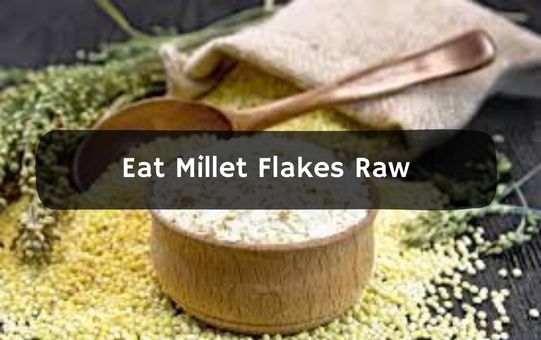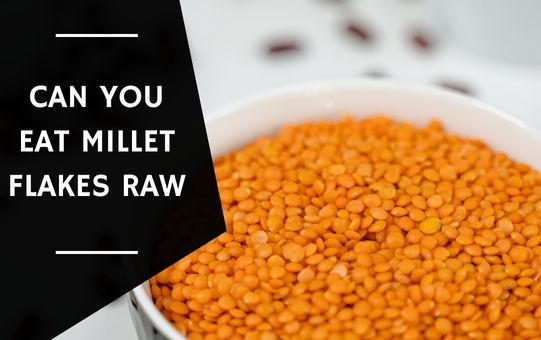Millet flakes are a healthy and delicious addition to any diet, but can you eat millet flakes raw?
Yes, it’s safe to consume raw millet flakes. However, it is essential to select high-quality flakes and consider the possibility of digestive discomfort if they are not properly prepared. Soaking or sprouting the flakes can increase their digestibility and enhance their flavor.
This article addresses the question of whether raw millet flakes are safe to consume and provides suggestions for incorporating them into a raw diet.
Contents
Why Can You Eat Millet Flakes Raw Matter?
The question of whether to eat millet flakes raw or cooked may matter to some people for a few reasons.
First, some people may prefer the taste and texture of raw millet flakes. Raw millet flakes have a slightly chewy texture and a mildly nutty flavor that some people may enjoy.
Second, some people may be interested in the nutritional benefits of raw millet flakes. It is thought that some nutrients, such as certain enzymes and antioxidants, may be more readily available in raw grains. However, it is important to note that the research on this topic is limited and more studies are needed to fully understand the potential differences in nutrient availability between raw and cooked grains.

Third, some people may be interested in eating raw millet flakes as a way to avoid the added calories and fat that come from cooking the flakes in oil or butter.
Finally, some people may be interested in raw flakes of millet as a way to support digestive health. Raw millet flakes can be soaked or sprouted, which can help to improve their digestibility and make them easier on the digestive system.
Read Also: Is Finger Millet And Millet The Same?
What are millet flakes?
Millet flakes are made by rolling whole millet grains into thin flakes. They are similar to oats in appearance and texture and are often used in a similar way.
Millet flakes can be eaten as a hot breakfast cereal, added to smoothies, or used in baking. They have a mild nutty flavor and a slightly chewy texture. Millet flakes are also sometimes referred to as “millet porridge flakes.”
Are millet flakes safe to eat raw?
There is no inherent risk associated with eating millet flakes raw. Millet is a safe and nutritious food that can be eaten in its raw form. However, there are a few considerations to keep in mind when eating millet flakes raw.
First, it is important to choose high-quality millet flakes that have been properly processed and stored. Millet is susceptible to contamination by fungi and other microorganisms, so it is important to ensure that the flakes you are using are clean and free from any potential contaminants.
Second, raw millet flakes may be harder to digest than cooked millet. While millet is a highly digestible grain, the outer layer of the grain (called the hull) can be difficult to digest if it is not properly cooked or processed.
This is not typically a concern when millet is cooked, as the heat and moisture of cooking help to soften the hull and make it more digestible. However, when millet is eaten raw, the hull may not be as easily digestible. This can lead to digestive discomfort or even bloating for some people.
can you eat millet flakes raw?
If you want to incorporate raw millet flakes into your diet, there are a few ways to do so. One option is to soak the flakes in water or milk overnight.
This helps to soften the flakes and make them more digestible. You can then drain the liquid and eat the soaked flakes as breakfast cereal, add them to smoothies, or use them in baking.
Another option is to sprout the millet flakes. Sprouting involves soaking the flakes in water for a period of time and then allowing them to germinate.
Sprouting helps to break down the hull of the grain, making it more digestible and increasing the availability of certain nutrients. Sprouted millet flakes can be eaten raw or cooked.
Can you eat millet raw?
Millet is a versatile grain that can be cooked in a variety of ways, but it is not recommended to eat raw still many people used to ask about can millet be eaten raw.
Raw millet is difficult to digest and contains certain compounds that can be harmful if consumed in large amounts. Moreover, it may contain microorganisms that can cause foodborne illness.
When millet is cooked, the heat and moisture break down its complex carbohydrates and make it easier for the body to digest. Cooking also helps to reduce the anti-nutrients present in millet, such as phytic acid, which can inhibit the absorption of certain nutrients in the body.
Therefore, it is recommended to always cook millet before consuming it to ensure its nutritional benefits and to avoid any potential health risks associated with consuming raw millet.
what happens if we eat raw millet?
Eating raw millet can cause digestive issues as it contains anti-nutrients such as phytic acid, which can interfere with the absorption of certain minerals and nutrients in the body.
Raw millet also contains enzymes that can be difficult for the body to digest. It is generally recommended to cook millet before consuming it to make it more easily digestible and to reduce the presence of anti-nutrients.
how to eat millet flakes?
Millet flakes can be a nutritious and versatile addition to a range of dishes. Here are a few ideas for how to eat millet flakes:
- Porridge: Cook millet flakes in milk or water, along with your favorite sweeteners and spices, to make a warm and comforting breakfast porridge.
- Granola: Combine millet flakes with rolled oats, nuts, seeds, and dried fruit to make a homemade granola that can be enjoyed with yogurt or milk.
- Baked goods: Use millet flakes in place of oats or other grains in your favorite baked goods, such as muffins, bread, or cookies.
- Salad topper: Sprinkle millet flakes on top of salads for added crunch and texture.
- Veggie burgers: Mix cooked millet flakes with mashed beans or other vegetables to make a tasty and nutritious veggie burger patty.
- Coating: Use millet flakes as a gluten-free alternative to breadcrumbs to coat fish, chicken, or vegetables before baking or frying.
When cooking with millet flakes, keep in mind that they have a relatively mild flavor and can take on the taste of other ingredients they are paired with. They also tend to cook quickly, so be sure to keep an eye on them and adjust cooking times as need
Read Also: Is It Good To Have Millet At Night?
Conclusion
It is safe to eat millet flakes raw. However, it is important to choose high-quality flakes and to consider the potential for digestive discomfort if the flakes are not properly prepared.
Soaking or sprouting the flakes can help to improve their digestibility and make them more enjoyable to eat. Overall, millet flakes are a nutritious and tasty addition to any diet, whether they are eaten raw or cooked.
FAQs | Eat Millet Flakes Raw
Here are a few FAQs related to eating millet flakes raw:
What Are Millet Flakes?
Millet flakes are thin flakes made from rolled whole millet grains. They have a mild nutty flavor and a slightly chewy texture and are often used in a similar way to oats.
Is It Safe To Eat Millet Flakes Raw?
Yes, it is safe to eat millet flakes raw. However, it is important to choose high-quality flakes and to consider the potential for digestive discomfort if the flakes are not properly prepared.
How Can I Prepare Millet Flakes To Make Them More Digestible When Eaten Raw?
Millet flakes can be soaked in water or milk overnight to soften them and make them more digestible.
Alternatively, they can be sprouted by soaking them in water and allowing them to germinate. Both of these methods can help to break down the outer hull of the grain and improve its digestibility.
Can I Use Raw Millet Flakes In Baking?
Yes, raw millet flakes can be used in baking. However, it is important to note that they may not provide the same texture and structure as cooked millet flakes or other grains. You may need to adjust your recipe accordingly.
can you eat Raw millet without cooking it?
No, it is not recommended to eat millet without cooking it. raw flakes of millet contain anti-nutrients such as phytic acid and enzymes that can be difficult for the body to digest, and cooking it helps to make it more easily digestible and reduces the presence of anti-nutrients.
can i eat raw millet?
Yes, you can eat raw millet, but it is recommended to cook or sprout it before consumption to improve digestibility and reduce the risk of potential digestive issues.

